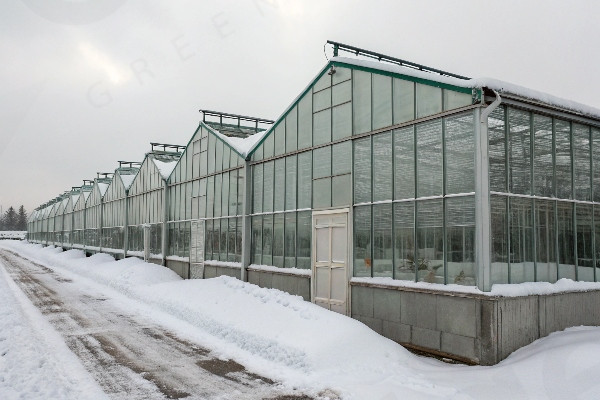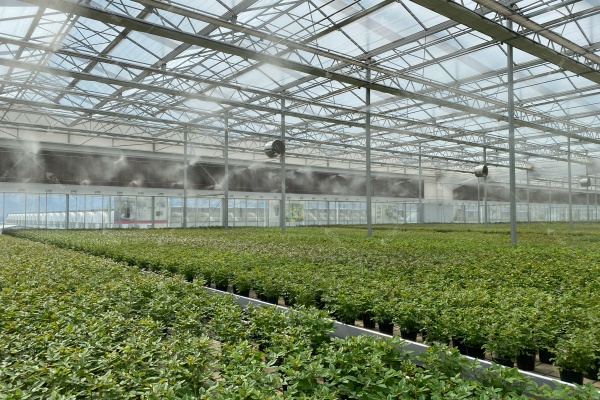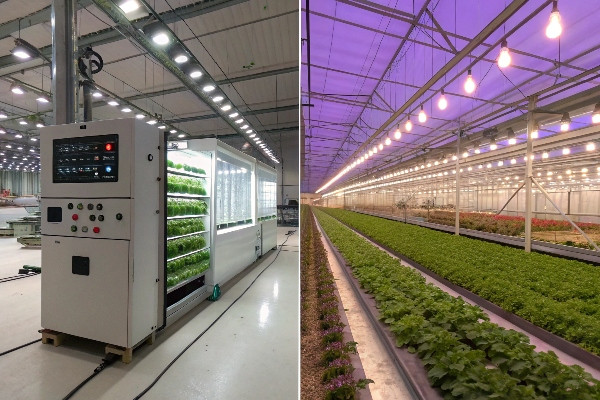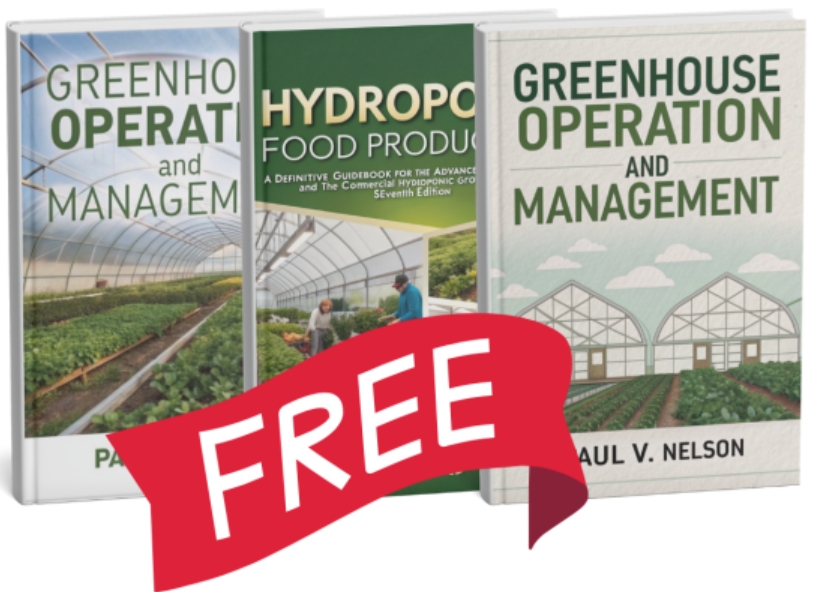Winter arrived early this year, and I watched my heating bills climb as temperatures dropped. My greenhouse was losing heat faster than I could generate it. This problem affects every grower in cold climates who wants to maintain productive growing conditions.
Preventing heat loss in greenhouses requires a systematic approach combining proper insulation materials, double-layer covering systems, thermal blankets, and strategic top insulation. These methods can reduce heating costs by up to 40% while maintaining optimal growing temperatures.

Last month, I visited a commercial operation in Canada where outside temperatures hit -25°C, yet their greenhouse maintained 18°C inside. The secret was not just powerful heaters, but smart heat retention systems that kept warm air where it belonged.
Don’t Miss:——Commercial Hydroponic Greenhouse Systems: How Do Design, Construction, and ROI Interconnect?
You might like:——What is a Smart Greenhouse? The Ultimate Guide to Automated Growing
How Do Insulation Materials Reduce Heat Loss?
The first winter I ran my greenhouse without proper insulation, I learned an expensive lesson. Heat escaped through every surface, and my heating system worked overtime just to maintain basic temperatures.
Insulation materials create thermal barriers that slow heat transfer through conduction, convection, and radiation. Quality insulation can reduce heat loss by 30-50% compared to uninsulated structures, directly cutting energy costs.
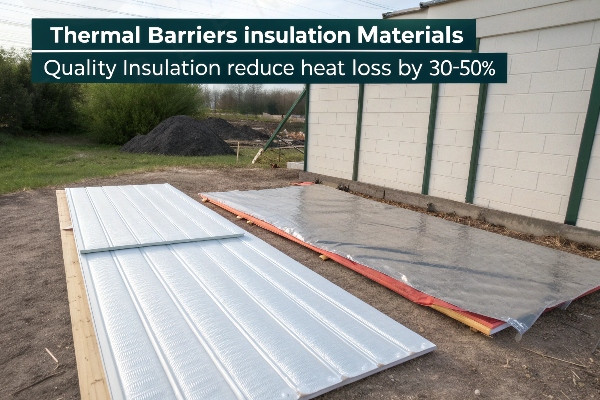
Understanding how heat moves helps us stop it from escaping. Heat travels in three ways: conduction through solid materials, convection through air movement, and radiation through electromagnetic waves. Each type needs different approaches to control.
Conduction happens when heat moves through materials like glass, plastic, or metal frames. Dense materials conduct heat faster than light, airy ones. This is why we use materials with low thermal conductivity for insulation. Air pockets work well because air does not conduct heat efficiently when it stays still.
Convection occurs when warm air rises and cool air sinks, creating circulation patterns. In greenhouses, this means warm air near the ceiling tries to escape while cold air enters from below. Proper sealing and air barriers prevent this unwanted air exchange.
Radiation is heat moving as invisible light waves. On cold nights, greenhouse surfaces radiate heat to the sky, which can be 20-30°C colder than air temperature. Reflective materials and thermal screens help reflect this heat back inside.
The most effective insulation systems address all three heat transfer methods. In my experience with CFGET installations, we use multi-layer approaches that combine different materials. For example, we might use foam boards for conduction control, sealed air gaps for convection control, and reflective films for radiation control.
Different climate zones require different insulation strategies. In humid regions like Southeast Asia, moisture control becomes critical because wet insulation loses effectiveness. In dry, cold areas like Central Asia, we focus on extreme temperature differences and wind protection.
| Insulation Type | Conduction Control | Convection Control | Radiation Control | Best Climate |
|---|---|---|---|---|
| Foam Boards | Excellent | Good | Poor | Dry, Cold |
| Reflective Films | Fair | Poor | Excellent | All Climates |
| Air Gaps | Good | Excellent | Fair | Moderate |
| Thermal Screens | Good | Excellent | Good | Variable |
How Much Better is Double-Layered Plastic Film Than Single Layer?
Three years ago, I compared two identical greenhouse sections – one with single-layer film and one with double-layer. The results surprised even me. The double-layer section used 35% less heating energy during the same winter period.
Double-layered plastic film provides 40-60% better insulation than single layer by creating an air gap that reduces heat transfer. This translates to 25-35% lower heating costs and more stable internal temperatures.

The science behind double-layer systems is straightforward but powerful. The air gap between layers acts as an insulator, similar to double-pane windows in buildings. This trapped air cannot move freely, so it cannot carry heat away through convection.
Single-layer films have thermal conductivity that allows heat to pass through relatively easily. When you add a second layer with an air gap, you create a thermal break. The inner layer stays warmer because it is not directly exposed to outside temperatures. The outer layer protects the inner layer from wind and weather.
Air gap thickness matters significantly. Too thin, and the air can still move and transfer heat. Too thick, and convection currents develop within the gap. The optimal gap ranges from 10-25mm depending on climate conditions and film type.
Installation quality determines performance. Proper inflation systems maintain consistent air pressure between layers. Uneven inflation creates hot spots where layers touch and cold spots where gaps are too large. We use specialized blower systems that automatically maintain optimal pressure.
Different film materials offer varying performance levels. Standard polyethylene provides basic insulation improvement. Specialized thermal films with infrared-blocking additives can improve performance by another 10-15%. Anti-condensation treatments prevent water droplets that reduce light transmission and insulation effectiveness.
The economic benefits extend beyond energy savings. More stable temperatures mean better crop growth and quality. Plants experience less stress from temperature fluctuations, leading to higher yields. In commercial operations, this often pays for the double-layer system within two growing seasons.
Maintenance requirements differ between systems. Single-layer films are easier to replace but need replacement more frequently due to weather exposure. Double-layer systems protect the inner layer, extending overall life but requiring more complex installation and repair procedures.
| Feature | Single Layer | Double Layer | Improvement |
|---|---|---|---|
| Heat Loss | High | Low | 40-60% reduction |
| Energy Cost | High | Lower | 25-35% savings |
| Temperature Stability | Variable | Stable | ±2°C improvement |
| Installation Cost | Low | Higher | 30-50% more |
| Lifespan | 2-3 years | 4-5 years | 60% longer |
Is Covering with Thermal Blankets at Night Important?
Last winter, I tested thermal blankets on half of my greenhouse and left the other half uncovered. The difference was dramatic – the covered section maintained temperatures 5-8°C higher on clear, cold nights without additional heating.
Thermal blankets deployed at night can reduce heat loss by 50-70% during the coldest hours. This practice alone can cut heating costs by 20-30% in cold climates while protecting crops from temperature shock.
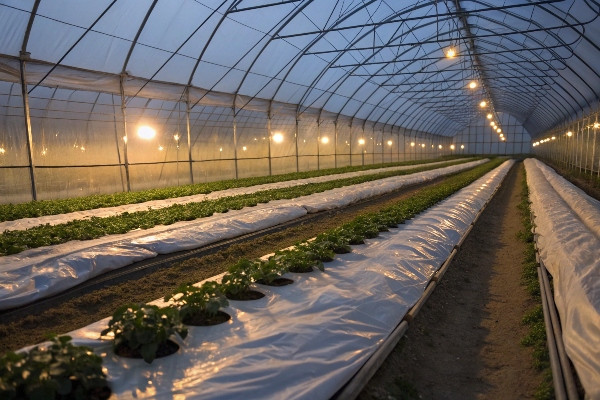
Night-time heat loss presents the biggest challenge in winter greenhouse management. During the day, solar radiation helps heat the greenhouse, but at night, the greenhouse becomes a heat radiator. Clear, cold nights are particularly problematic because the greenhouse radiates heat to the sky, which can be much colder than air temperature.
Thermal blankets work by creating an additional insulation layer that can be deployed when needed. During the day, blankets retract to allow maximum light penetration for photosynthesis. At night, they extend to create a thermal barrier between the crop and the cold greenhouse covering.
The material composition of thermal blankets affects their performance. Multi-layer blankets typically include an outer layer for durability, insulation layers for thermal protection, and a reflective layer to redirect radiant heat back to the plants. Some blankets also include permeable layers that allow air circulation while maintaining thermal protection.
Timing of blanket deployment is critical. Deploying too early reduces daylight hours for plants. Deploying too late allows heat to escape. Most commercial systems use temperature sensors and automated controls to deploy blankets when outside temperatures drop below predetermined thresholds, typically 2-3°C above the desired internal temperature.
Different crops require different thermal management strategies. Heat-loving crops like tomatoes and peppers benefit from blankets that maintain temperatures above 15°C. Cool-season crops might only need protection from extreme cold. Understanding your specific crop requirements helps optimize blanket use.
The automation level affects both effectiveness and labor costs. Manual systems require daily attention and can be inconsistent. Semi-automated systems with manual override provide good control with reasonable labor requirements. Fully automated systems with weather station integration optimize deployment timing but require higher initial investment.
Maintenance and care of thermal blankets significantly impact their lifespan and effectiveness. Proper storage during non-use periods prevents damage. Regular cleaning removes dust and debris that can reduce thermal performance. Prompt repair of tears or holes maintains system integrity.
| Blanket Type | Insulation Value | Light Transmission | Automation Level | Cost Range |
|---|---|---|---|---|
| Single Layer | 30-40% heat retention | 85-90% | Manual/Semi | Low |
| Double Layer | 50-60% heat retention | 70-80% | Semi/Auto | Medium |
| Aluminized | 60-70% heat retention | 60-70% | Auto | High |
| Specialized | 70-80% heat retention | 80-85% | Auto | Premium |
How Critical is Top Insulation for Large Greenhouses?
When I first started working with large commercial greenhouses, I underestimated the importance of top insulation1. Heat rises, and in a 10,000 square meter greenhouse, the roof becomes the primary heat loss surface. Without proper top insulation, heating costs can be 40-50% higher than necessary.
Top insulation is critical for large greenhouses because the roof area represents 40-60% of total heat loss surface. Proper roof insulation systems can reduce overall heating costs by 25-40% while improving temperature uniformity throughout the growing space.

Large greenhouses present unique challenges compared to smaller structures. The roof area increases dramatically with size, creating more surface area for heat loss. Additionally, the height of large structures creates stronger convection currents that can accelerate heat loss through the roof.
The physics of heat movement in large spaces differs from smaller greenhouses. In small structures, wall heat loss might dominate, but in large greenhouses, the roof becomes the primary heat loss path. Warm air rises to the peak, where it encounters cold roof surfaces and loses heat rapidly.
Different roof insulation systems2 serve different purposes. Fixed insulation provides constant thermal protection but reduces light transmission. Moveable insulation systems allow maximum light during the day and thermal protection at night. Hybrid systems combine both approaches for optimal performance.
Material selection for large roof areas requires careful consideration of weight, durability, and maintenance access. Lightweight materials reduce structural loads but may sacrifice insulation performance. Heavy-duty materials provide better insulation but require stronger support structures.
Installation complexity increases with greenhouse size. Large roofs require specialized equipment and safety procedures. Weather windows for installation become more critical because partially completed installations can be vulnerable to wind damage.
The economic impact of roof insulation scales with greenhouse size. A 10% reduction in heating costs3 for a 1,000 square meter greenhouse might save $2,000 annually, while the same percentage reduction for a 10,000 square meter greenhouse could save $20,000 or more.
Different climate zones require adapted approaches. In regions with heavy snow loads, insulation systems must support additional weight. In areas with high winds, systems need enhanced anchoring. Hot climates might require cooling-focused insulation that reflects summer heat while retaining winter warmth.
Maintenance access becomes more challenging with large roof areas. Systems should be designed for safe access and regular inspection. Automated systems with remote monitoring can reduce maintenance requirements while ensuring optimal performance.
| Greenhouse Size | Roof Heat Loss % | Insulation Priority | Typical Savings | System Complexity |
|---|---|---|---|---|
| Small (<500m²) | 30-40% | Medium | $1,000-3,000 | Simple |
| Medium (500-2000m²) | 40-50% | High | $3,000-8,000 | Moderate |
| Large (2000-5000m²) | 50-60% | Critical | $8,000-20,000 | Complex |
| Very Large (>5000m²) | 60-70% | Essential | $20,000+ | Advanced |
At CFGET, we have developed specialized solutions for different greenhouse sizes and climates. Our slope design additions provide extra wind protection while creating double-layer insulation effects for film greenhouses. This approach works particularly well in Central Asian climates where extreme temperature differences and high winds create challenging conditions.
For Southeast Asian markets, we focus on insulation systems that also manage humidity and prevent condensation. The combination of temperature control and moisture management ensures both energy efficiency and crop health.
In European and American markets, we emphasize precision control systems that integrate with existing automation platforms. These systems provide detailed monitoring and control capabilities that help growers optimize their operations for both efficiency and sustainability certifications.
Conclusion
Preventing heat loss requires a systematic approach combining multiple insulation strategies. Proper implementation can reduce heating costs by 30-50% while improving crop quality and yield consistency.
Understanding the impact of top insulation can help optimize heating costs and improve crop yields in large greenhouses. ↩
Exploring various roof insulation systems can lead to better energy efficiency and cost savings in greenhouse operations. ↩
Reducing heating costs is crucial for profitability; learn strategies to achieve significant savings in greenhouse management. ↩
